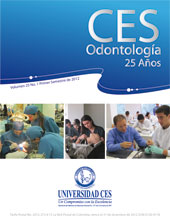Alternativas para el tratamiento de hipoplasias maxilares.(Treatment alternatives for maxillary hypoplasia)
Abstract
LamaloclusiónclaseIIIporhipoplasiamaxilarconllevaagrandescompromisosestéticosyfuncionales
alospacientesquelapadecen. Atravésdelainvestigacionsehandesarrolladodiferentesmodalidades
terapéuticas según la severidad del problema. Los pacientes con grandes hipoplasias como los que padecenalteracionescraneofacialesduranteelcrecimientosontratadosusualmentecondistracción
osteogénica maxilar luego de una lefort I, en pacientes con hipoplasia leve a moderada con mascara facial la cual genera efectos dentoalveolares desfavorables , indeseables e inevitables. Para reducir estos efectos, los métodos de anclaje óseo han sido desarrollados: mascara facial con anclaje óseos,
protracción maxilar con anclajes óseos bimaxilar eliminando el uso de la mascara. Los estudios preliminaresmuestranresultadospromisoriosparaestaúltimamodalidadsobretodoparapacientes
en dentición mixta tardía o permanente temprana. Esta revisión describe o compara las ventajas y desventajas así como los efectos de las diferentes alternativas para tratar de manera temprana la clase III por hipoplasia maxilar.
Abstract
Class III skeletal malocclusion due to maxillary hypoplasia, compromises esthetics and functional aspects of patients. Different types of treatment have been developed depending on the severity of the deformity. Patients with severe maxillary hypoplasia and those with craniofacial abnormalities are normally treated with an ostegenic distraction after a Lefort I surgery. Mild to moderate skeletal class III patients are treated with facial mask combined with an intraoral device that usually produces dentoalveolar effects secondary to the maxillary protraction that sometimes are not desirable. Recently new methods of intraoral anchorage have been reported to be use with the traditional face mask, such as oseointegrated implants and miniplates. Also bimaxillary miniplates used with
intermaxillary elastics can replace the extraoral appliance. These new approach has less or none dentoalveolareffectsandthereforecanbeconsideredanidealtreatmentoptionforamixeddentition
patient. The present review compares the effects, advantages and disadvantages of the different treatments available for class III skeletal malocclusion.
Downloads
Downloads
Published
How to Cite
Issue
Section
| Article metrics | |
|---|---|
| Abstract views | |
| Galley vies | |
| PDF Views | |
| HTML views | |
| Other views | |



